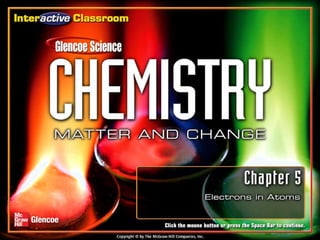Cmc chapter 05
•Download as PPT, PDF•
10 likes•4,032 views
This document is an outline for a chapter on electrons in atoms. It is divided into three main sections: Section 5.1 discusses light and quantized energy, including the wave and particle properties of light and photons. Section 5.2 covers the quantum theory of the atom, comparing the Bohr and quantum mechanical models. It introduces atomic orbitals and quantum numbers. Section 3 discusses electron configuration, including the rules for determining configuration, valence electrons, and representing configurations with diagrams and symbols.
Report
Share
Report
Share

Recommended
Recommended
More Related Content
What's hot
What's hot (20)
Chemistry - Chp 5 - Electrons In Atoms - Powerpoint

Chemistry - Chp 5 - Electrons In Atoms - Powerpoint
Similar to Cmc chapter 05
Similar to Cmc chapter 05 (20)
202006151236284892NK-Bohr Model of Hydrogen Atom.pdf

202006151236284892NK-Bohr Model of Hydrogen Atom.pdf
More from Jane Hamze
More from Jane Hamze (18)
Recently uploaded
Recently uploaded (20)
PSYPACT- Practicing Over State Lines May 2024.pptx

PSYPACT- Practicing Over State Lines May 2024.pptx
II BIOSENSOR PRINCIPLE APPLICATIONS AND WORKING II

II BIOSENSOR PRINCIPLE APPLICATIONS AND WORKING II
Implanted Devices - VP Shunts: EMGuidewire's Radiology Reading Room

Implanted Devices - VP Shunts: EMGuidewire's Radiology Reading Room
The Ball Poem- John Berryman_20240518_001617_0000.pptx

The Ball Poem- John Berryman_20240518_001617_0000.pptx
Spring gala 2024 photo slideshow - Celebrating School-Community Partnerships

Spring gala 2024 photo slideshow - Celebrating School-Community Partnerships
Features of Video Calls in the Discuss Module in Odoo 17

Features of Video Calls in the Discuss Module in Odoo 17
Including Mental Health Support in Project Delivery, 14 May.pdf

Including Mental Health Support in Project Delivery, 14 May.pdf
Đề tieng anh thpt 2024 danh cho cac ban hoc sinh

Đề tieng anh thpt 2024 danh cho cac ban hoc sinh
Exploring Gemini AI and Integration with MuleSoft | MuleSoft Mysore Meetup #45

Exploring Gemini AI and Integration with MuleSoft | MuleSoft Mysore Meetup #45
When Quality Assurance Meets Innovation in Higher Education - Report launch w...

When Quality Assurance Meets Innovation in Higher Education - Report launch w...
Cmc chapter 05
- 2. Chapter Menu Electrons in Atoms Section 5.1 Light and Quantized Energy Section 5.2 Quantum Theory and the Atom Section 5.3 Electron Configuration Exit Click a hyperlink or folder tab to view the corresponding slides.
- 4. Section 5-1 Section 5.1 Light and Quantized Energy (cont.) electromagnetic radiation wavelength frequency amplitude electromagnetic spectrum Light, a form of electronic radiation, has characteristics of both a wave and a particle. quantum Planck's constant photoelectric effect photon atomic emission spectrum
- 9. Section 5-1 The Wave Nature of Light (cont.)
- 12. Section 5-1 The Wave Nature of Light (cont.)
- 17. Section 5-1 Atomic Emission Spectra (cont.)
- 21. End of Section 5-1
- 23. Section 5-2 Section 5.2 Quantum Theory and the Atom (cont.) ground state quantum number de Broglie equation Heisenberg uncertainty principle Wavelike properties of electrons help relate atomic emission spectra, energy states of atoms, and atomic orbitals. quantum mechanical model of the atom atomic orbital principal quantum number principal energy level energy sublevel
- 28. Section 5-2 Bohr's Model of the Atom (cont.)
- 29. Section 5-2 Bohr's Model of the Atom (cont.)
- 35. Section 5-2 The Quantum Mechanical Model of the Atom (cont.)
- 41. Section 5-2 Hydrogen Atomic Orbitals (cont.)
- 44. End of Section 5-2
- 46. Section 5-3 Section 5.3 Electron Configuration (cont.) electron configuration aufbau principle Pauli exclusion principle Hund's rule valence electrons electron-dot structure A set of three rules determines the arrangement in an atom.
- 48. Section 5-3 Ground-State Electron Configuration (cont.)
- 50. Section 5-3 Ground-State Electron Configuration (cont.)
- 54. Section 5-3 Valence Electrons (cont.)
- 57. End of Section 5-3
- 58. Resources Menu Chemistry Online Study Guide Chapter Assessment Standardized Test Practice Image Bank Concepts in Motion
- 73. IB Menu Click on an image to enlarge.
- 74. IB 1
- 75. IB 2
- 76. IB 3
- 77. IB 4
- 78. IB 5
- 79. IB 6
- 80. IB 7
- 81. IB 8
- 82. IB 9
- 83. IB 10
- 84. IB 11
- 85. IB 12
- 86. IB 13
- 87. IB 14
- 88. IB 15
- 89. IB 16
- 90. IB 17
- 91. IB 18
- 92. IB 19
- 93. IB 20
- 94. IB 21
- 95. IB 22
- 96. CIM Figure 5.11 Balmer Series Figure 5.12 Electron Transitions Table 5.4 Electron Configurations and Orbital Diagrams for Elements 1–10 Table 5.6 Electron Configurations and Dot Structures
- 97. Help Click any of the background top tabs to display the respective folder. Within the Chapter Outline, clicking a section tab on the right side of the screen will bring you to the first slide in each respective section. Simple navigation buttons will allow you to progress to the next slide or the previous slide. The “Return” button will allow you to return to the slide that you were viewing when you clicked either the Resources or Help tab. The Chapter Resources Menu will allow you to access chapter specific resources from the Chapter Menu or any Chapter Outline slide. From within any feature, click the Resources tab to return to this slide. To exit the presentation, click the Exit button on the Chapter Menu slide or hit Escape [Esc] on your keyboards while viewing any Chapter Outline slide.
- 98. End of Custom Shows This slide is intentionally blank.